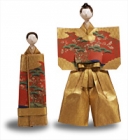Japanese Gallery (Honkan) Room 14
February 27, 2007 (Tue) - April 8, 2007 (Sun)
According to the old lunar calendar, the third day of the third month is the date of the peach blossom festival. Hina dolls are beautifully displayed on this occasion within each family to celebrate and pray for a healthy and safe childhood for their daughters. The origins of this tradition are unclear, but records reveal it was an annual event by the early Edo period.
The Edo guidebook "Edo Kanoko", which was written during the Jokyo era (1684 - 88), mentions hina doll markets being opened at several locations within Edo: Nakabashi, Owarimachi, Jukkendana, Ningyocho, and Kojimachi. Standing hina dolls made of paper, which were not very different from the human-shaped paper charms used in magical rites during the Heian period, were the main type during the first half of the Edo period.
In the mid-Edo period, hina dolls developed into the seated posture type with courtly attire, which included the Muromachi-bina doll displaying Muromachi fashion, the Kyoho-bina as the original type of the later popular Dairi-bina (representing an imperial couple), the Kansai style Jirozaemon-bina with a round white face, and the Kokin-bina that was popular in Edo. Even after the wide distribution of seated hina dolls, the old standing types were still displayed along with the seated dolls on the display stand.
Today, it has become standard to display one imperial couple of hina dolls, yet earlier the manner of display was not restricted. Old pictorial sources show many different dolls being displayed liberally. The term hina derives from hina-gata, the term for "miniature". Delicately crafted, these hina dolls show the affection and tastes of the maker as well as the customer, reflecting the nature of the Japanese people who love "hinagata" minature objects.

